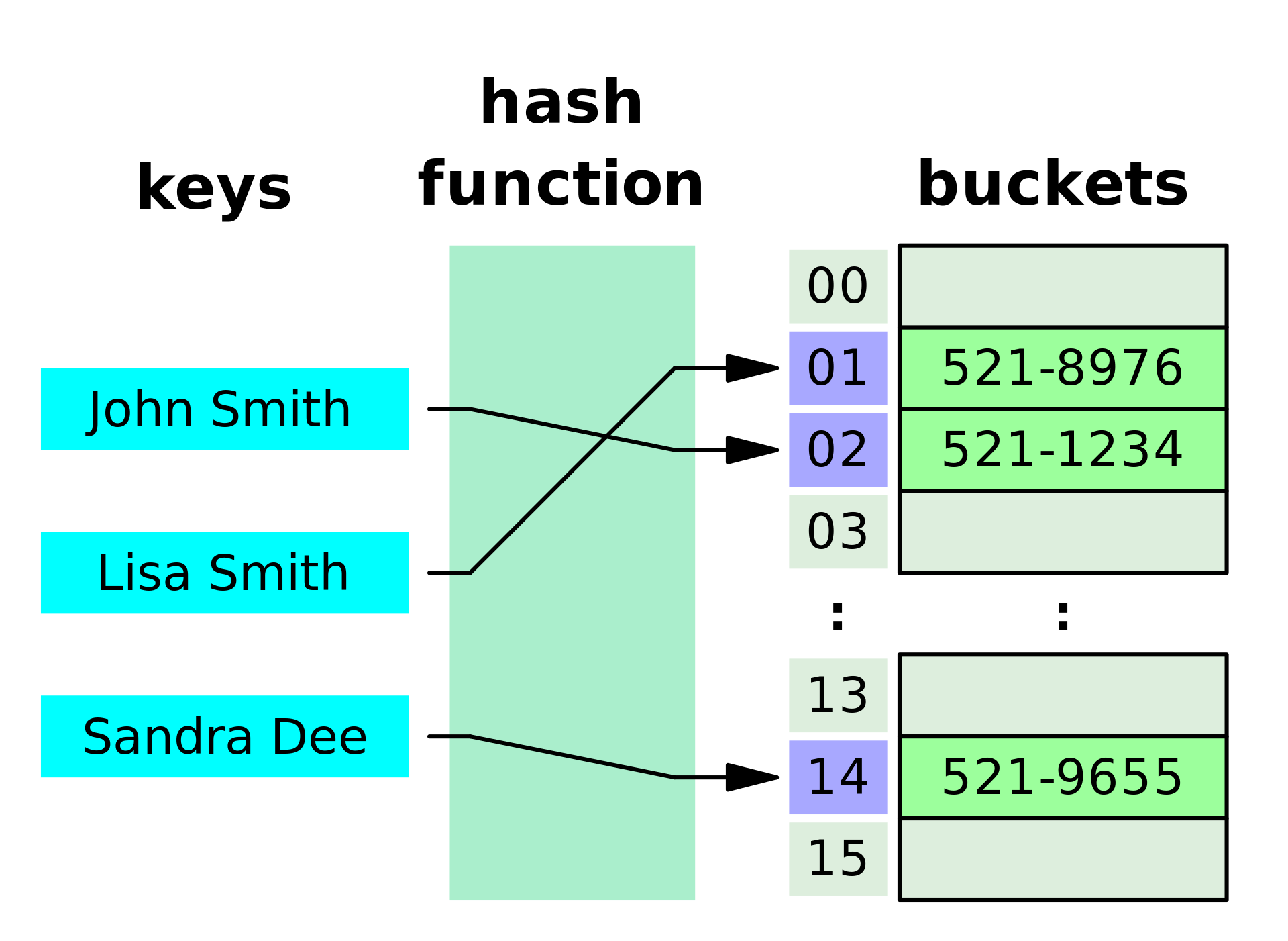해쉬 테이블(Hash Table)
- Hash Table이란 키(key)에 데이터(value)를 저장하는 데이터 구조다.
- key를 통해 데이터를 바로 받아올 수 있어 속도가 빠르다.
- 파이썬 딕셔너리(dictionary) 타입이 해쉬 테이블의 예이다.
- 보통 배열로 미리 Hash Table 사이즈만큼 생성 후 사용한다. (공간과 탐색 시간을 맞바꾸는 기법)
- 파이썬에서는 딕셔너리가 있기 때문에 해쉬를 별도로 구현할 필요가 없다.

해쉬 테이블 용어설명
- 해쉬(Hash) : 임의 값을 고정 길이로 변환하는 것
- 해쉬 테이블(Hash Table) : 키값의 연산에 의해 직접 접근이 가능한 데이터 구조
- 해싱 함수(Hashing Function) : Key에 대해 산술 연산을 이용해 데이터 위치를 찾을 수 있는 함수
- 해쉬 값(Hash Value) 또는 해쉬 주소(Hash Address) : Key를 해싱 함수로 연산해서 해쉬 값을 알아내고, 이를 기반으로 해쉬 테이블에서 해당 Key에 대한
데이터 위치를 일관성 있게 찾을 수 있음 - 슬롯(slot): 한 개의 데이터를 저장할 수 있는 공간
- 저장할 데이터에 대해 Key를 추출할 수 있는 별도 함수도 존재할 수 있음
해쉬 테이블 만들기
직접 코드로 구현해보자!
hash_table = list([i for i in range(10)]) print(hash_table) # [0,1,2,3,4,5,6,7,8,9]
해쉬 함수
- 다양한 해쉬 함수 고안 기법 중, 가장 간단한 방식은 Division 법(나누기를 통한 나머지 값을 사용하는 기법)
def hash_func(key): return key % 5
이제 해쉬 테이블에 저장해보자.
- 데이터에 따라 필요시 key 생성 방법 정의가 필요하다.
data1 = 'changhyeon' data2 = 'choi' data3 = 'star' data4 = 'bucks' print(ord(data1[0]), ord(data2[0]), ord(data3[0])) # 99 99 115 print(ord(data1[0]), hash_func(ord(data1[0]))) # 99 4 print(ord(data1[0]), ord(data4[0])) # 99 98
!해쉬 테이블 값 저장 예시
- data: value와 같이 data와 value를 넣으면, 해당 data에 대한
key를 찾아서, 해당 key에 대응하는 해쉬주소에 value를 저장하는 예
def storage_data(data, value): key = ord(data[0]) hash_address = hash_func(key) hash_table[hash_address] = value storage_data('changhyeon', '19950807')
!데이터 읽어보기
def get_data(data): key = ord(data[0]) hash_address = hash_func(key) print(hash_table[hash_address]) get_data('changhyeon') # 19950807
해쉬 테이블의 장단점
- 장점
데이터 저장/읽기 속도가 빠름(검색 속도 빠름!)
해쉬는 키에 대한 데이터가 있는지(중복) 확인이 쉬움 - 단점
일반적으로 저장공간이 좀 더 많이 필요함
여러 키에 해당하는 주소가 동일할 경우, 충동을 해결하기 위한 별도 자료구조가 필요 - 주요 용도s
검색이 많이 필요한 경우
저장, 삭제, 읽기가 빈번한 경우
캐쉬 구현시(중복 확인이 쉽기 때문)
해쉬 테이블의 시간 복잡도
- 일반적인 경우(Collision이 없는 경우)
O(1) - 최악의 경우(Collision이 모두 발생하는 경우)
O(n)
해쉬 테이블 구현해보기
리스트 변수를 활용해서 해쉬 테이블을 구현해보자!
- 해쉬 함수: key ^% 8
- 해쉬 키 생성: hash(data)
hash_table = list([0 for i in range(8)]) print(hash_table) #[0, 0, 0, 0, 0, 0, 0, 0] def get_key(data): return hash(data) get_key('changhyeon') # -470506737412036400 def hash_func(key): return key % 8 def save_data(data, value): hash_address = hash_func(get_key(data)) hash_table[hash_address] = value def read_data(data): hash_address = hash_func(get_key(data)) print(hash_address) print(hash_table[hash_address]) save_data('changhyeon', '01091616424') save_data('ch', '01012345678') read_data('changhyeon') #4 #01012345678 read_data('ch') #4 # 01012345678 print(hash_table) #[0, 0, 0, 0, '01012345678', 0, 0, 0]

